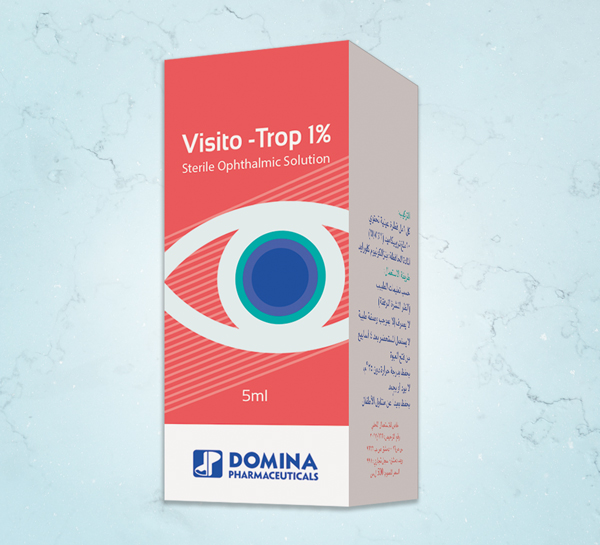
COMPOSITION:
Each 1ml sterile ophthalmic Solution contains 1o g Tropicamide ( 1% w/v)
Preservative: Benzalkonium Chloride
CLINICAL PHARMACOLOGY:
This anticholinergic preparation blocks the responses of the sphincter muscle of the iris and the ciliary muscle to cholinergic stimulation, dilating the pupil (mydriasis). The stronger preparation (1%) also paralyzes accommodation. This preparation acts in 15-30 minutes, and the duration of activity is approximately 3-8 hours. Complete recovery from mydriasis in some individuals may require 24 hours.
INDICATIONS:
For mydriasis and cycloplegia for diagnostic procedures.
CONTRAINDICATIONS:
Contraindicated in persons showing hypersensitivity to any component of this preparation.
Glaucoma or a tendency towards glaucoma (e.g. Narrow anterior chamber angle).
WARNINGS:
- For topical ophthalmic use only. Not for injection.
- This preparation may cause CNS disturbances which may be dangerous in pediatric patients. The possibility of psychotic reactions and behavioral disturbances due to hypersensitivity to anticholinergic drugs should be considered.
- Mydriatics may produce a transient elevation of intraocular pressure.
- Remove contact lenses before using.
- Tropicamide-induced psychotic reactions and behavioral disturbances may occur in patients with increased susceptibility to anticholinergic drugs.
- Use with caution in an inflamed eye as the hyperaemia greatly increases the rate of systemic absorption through the conjunctiva. To reduce systemic absorption the lacrimal sac should be compressed at the medial can thus by digital pressure for at least two minutes after instillation of the drops.
- Mydriacyl contain benzalkonium chloride which may cause eye irritation and is known to discolour soft contact lenses.
- Pediatric Population
Tropicamide may cause central nervous system disturbances, which may be dangerous in infants and children.
Excessive use in children may produce systemic toxic symptoms. Use with extreme caution in infants, small or premature children, or children with Down syndrome, spastic paralysis or brain damage.
Parents should be warned of the oral toxicity of this preparation for children and advised to wash their own hands and the child's hands after use.
PRECAUTIONS:
General:
The lacrimal sac should be compressed by digital pressure for two to three minutes after instillation to reduce excessive systemic absorption.
Information for Patients:
Do not touch dropper tip to any surface, as this may contaminate the solution.
Patient should be advised not to drive or engage in potentially hazardous activities while pupils are dilated.
Patient may experience sensitivity to light and should protect eyes in bright illumination during dilation.
Parents should be warned not to get this preparation in their child's mouth and to wash their own hands and the child's hands following administration.
Drug Interactions:
Tropicamide may interfere with the antihypertensive action of carbachol, pilocarpine, or ophthalmic cholinesterase inhibitors.
The effect of anti-muscarinic agents may be enhanced by the concomitant administration of other drugs with anti-muscarinic properties such as amantadine, some anti-histamines, antipsychotics, phenothiazines and tricyclic anti-depressants.
If more than one topical ophthalmic medicinal product is being used, the medicines must be administered at least 5 minutes apart. Eye ointments should be administered last.
Pregnancy and Lactation:
Tropicamide should be given to a pregnant woman only if clearly needed.
Caution should be exercised when tropicamide is administered to a nursing woman.
Pediatric Use:
Tropicamide may rarely cause CNS disturbances which may be dangerous in pediatric patients.
Psychotic reactions, behavioral disturbances, and vasomotor or cardiorespiratory collapse in children have been reported with the use of anticholinergic drugs.
Geriatric Use:
No overall differences in safety or effectiveness have been observed between elderly and younger patients.
ADVERSE REACTIONS:
Ocular: Transient stinging, blurred vision, photophobia and superficial punctate keratitis have been reported with the use of tropicamide. Increased intraocular pressure has been reported following the use of mydriatics.
Non-Ocular: Dryness of the mouth, tachycardia, headache, allergic reactions, nausea, vomiting, pallor, central nervous system disturbances and muscle rigidity have been reported with the use of tropicamide.
Psychotic reactions, behavioral disturbances, and vasomotor or cardio-respiratory collapse in children have been reported with the use of anticholinergic drugs.
DOSAGE AND ADMINISTRATION:
Adults, Elderly and children:
Fundoscopy:
One or two drops of 0.5% solution instilled into the eyes 15 to 20 minutes prior to examination.
Cycloplegic Refraction:
One or two drops of 1% solution repeated after 5 minutes. If the patient is not seen within 20 to 30 minutes an additional drop may be instilled to prolong the effect.
Use in Children:
Tropicamide has been reported to be inadequate for cycloplegia in children. A more powerful cycloplegic agent such as atropine may be required. Do not use in concentrations greater than 0.5% in small infants .
Method of administration:
- For topical ophthalmic use only.
- Nasolacrimal occlusion or gently closing the eyelid after administration is recommended. This may reduce the systemic absorption of medicinal products administered via the ocular route and result in a decrease in systemic adverse reactions.
- If more than one topical ophthalmic product is being used, the products must be administered at least 5 minutes apart. Eye ointments should be administered last.